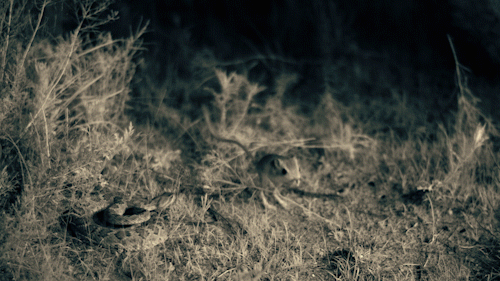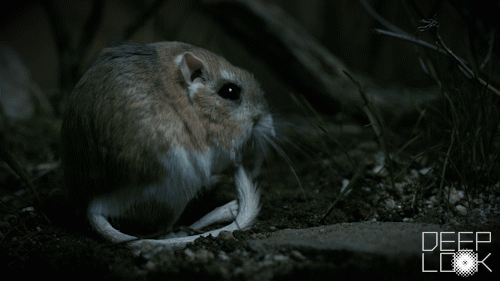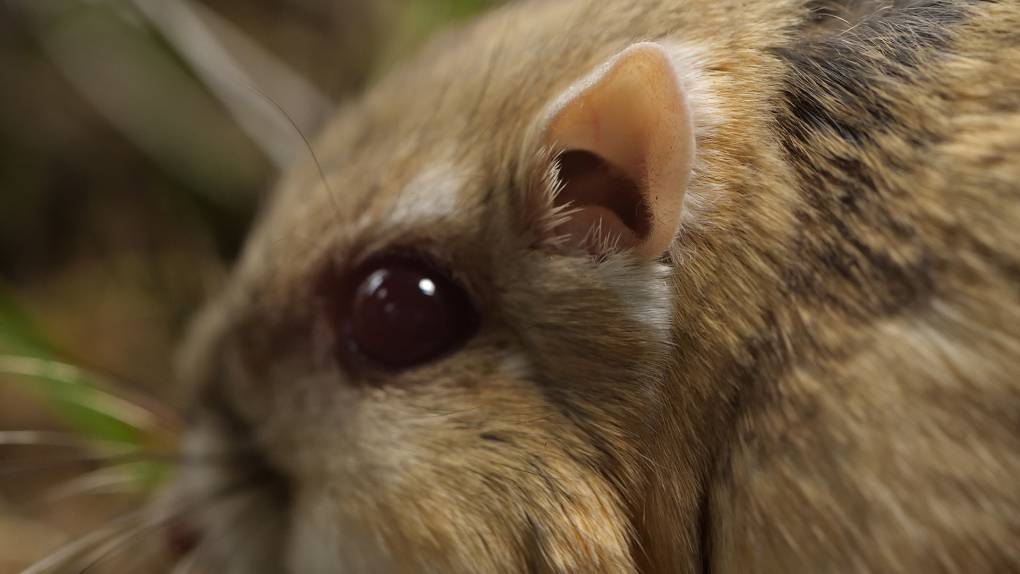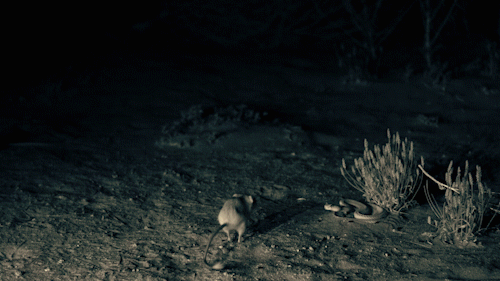Kangaroo Rats Are Furry, Spring-Loaded Ninjas
Rulon Clark had a problem.
He had studied rattlesnakes for years, but he wanted to learn more about the kangaroo rat, a diminutive animal that venomous snakes try to eat in deserts of the American West.
When Clark, an associate professor of biology at San Diego State University, and his team set up cameras to attempt to film interactions between predator and prey in the deserts of Southern California and Arizona, they came up empty.
Whenever they were lucky enough to actually record a rattlesnake attacking the rats, the footage only captured a blur.
“You can’t really tell what’s going on,” said Malachi Whitford, a doctoral student working with Clark at San Diego State. “We couldn’t even tell that the kangaroo rat got bit, or if it did get bit, what happens. It’s usually about 200 milliseconds. This is about the same speed that you blink an eye.”
Clark, Whitford and the other researchers persisted, using high-speed cameras to capture the video at a much higher quality. To their surprise, they discovered the humble kangaroo rats are actually like tiny ninjas, able to execute jaw-dropping feats of agility and defensive maneuvers — leaping as high as nine feet in the air in a split second to evade snake attacks in pitch darkness.
“They have this incredible athleticism — this combination of speed, power, agility and jumping,” Clark said.

As the team painstakingly gathered more examples of extreme slow-motion video of rattlesnakes ambushing kangaroo rats, the scientists discovered an astonishing array of acrobatic skills that these fuzzy seed-foragers use to survive. The slow-motion nighttime videos revealed a range of behaviors that weren’t previously observed.
Even more fascinating, Clark said, was that the rats often got away.
In the 32 interactions filmed by the researchers, they found that half of the time the snakes did manage to actually bite a kangaroo rat, but the rodent was able to kick the snake, or roll its body away in time, so that the snake was not able to inject its venom, and the rat usually survived.
“Prior to seeing this slowed way down,” Clark said, “we kind of just thought, well, once the fangs are in, it squeezes the glands, venom’s in, and the whole thing’s done. But it turns out there’s this whole kind of second high-speed battle that happens.”
The team published some of its findings last year in Functional Ecology, a scientific journal.
To capture the intense high-speed battles in extreme slow-motion took a lot of trial and error, and highly specialized equipment. Clark, Whitford, and San Diego State University graduate student Grace Freymiller worked with Tim Higham, an associate professor of biology at UC Riverside who specializes in scientific imaging techniques, to set up high-speed cameras with infrared sensors, enabling them to essentially see in the dark.
Using a special tracking method developed to study rattlesnake ecology (implanting tiny transmitters in the snakes), the team could locate the sidewinder and Mojave rattlesnakes as they made their nighttime feeding rounds. Once they found the snakes, often curled up, lying in wait to ambush unsuspecting passersby, the scientists delicately went about setting up their infrared floodlights and remote camera setups.
They used infrared light because it didn’t bother the kangaroo rats or the snakes, so the cameras they were using had sensors that were specifically tuned to record infrared images. Whenever they used their normal headlamps, it would spook the kangaroo rats.
The team hiked the cameras and infrared lights, along with the heavy 12-volt car batteries that power them, into far corners of the deserts near Mojave, California and Yuma, Arizona. Once set up, they waited — often for hours without luck. But when they were lucky enough to film a snake attempting to ambush a kangaroo rat, the results were frequently fascinating.

The two species the researchers recorded are the desert kangaroo rat and Merriam’s kangaroo rat, both of which are commonly found in the deserts of southern California and Arizona. Most of the snakes in the study were the sidewinder rattlesnake, but the team also recorded strikes by the Mojave rattlesnake.
Kangaroo rats are considered by ecologists to be critical for dispersing seeds and aerating the desert soil with their extensive networks of burrows, spending most of their outdoor time foraging.
They pull, husk and stuff the seeds into their fur-lined cheek pouches with their tiny hands, which are tucked below their chin. The seeds provide their primary sources of food and water in the harsh deserts, and they consume so little liquid that they rarely ever pee.
As they forage, kangaroo rats need to continually scan the surrounding sandy environment for any predators — foxes, owls, and snakes — that could be anywhere. Once a well-camouflaged sidewinder rattlesnake strikes, aiming its venomous fangs at the furry seed-harvester, the kangaroo rat springs up, and away from the snake’s deadly bite, kicking its powerful hind legs at the snake’s face, and using its long tail to twist itself in mid-air, away from the snake to safety.
It’s not only the kangaroo rat’s ability to jump high and perform incredible acrobatics that protects it from snakes. It’s the ability to jump high at just the right moment. Biologists believe that this skill most likely comes from its keen hearing, which is 90 times more sensitive than human ears, allowing the rats to react in as little as 50 milliseconds.
Kangaroo rats have evolved so that the bone structure around their ears, called the tympanic bullae, act as natural amplifiers for the smallest of sounds, kind of like built-in radar dish receivers on either side of their tiny skulls.
Overall, their ear structure-to-body ratio is far higher than most other animals.

“Relative to the size of their head they blow all the other animals out of the water,” said biologist Clint Collins at Sacramento State University.
In addition to their finely-tuned ears, the desert kangaroo rats’ highly-evolved musculature generates lots of force very quickly, resulting in jumps almost ten times their body height. It’s not the highest jump in nature, but it’s fast enough to avoid the lunging jaws of the rattlesnake.
“They seem to be kind of little balls of fast-twitch muscle fibers,” Clark said.
The rats have evolved as specialists in power over endurance in their legs, similar to the difference between the muscles in a human weight-lifter and the legs of a long-distance runner.
Kangaroo rats have a thick tendon, surrounded by large muscles, which translates directly to more power and a faster reaction time. With its powerful hind limbs, the kangaroo rat is also able to deliver a strong kick to the jaw of the rattlesnake, sending the rattlesnake crashing to the ground, before landing away from the snake — all in fractions of a second.
The behaviors that had initially piqued Clark’s curiosity turned out to be only part of a wide range of highly evolved and effective anti-predator behaviors aimed specifically at rattlesnakes. In his earlier research Clark found that once a kangaroo rat avoids a snake strike, it appears to hang around to almost tease the foiled predator.
“It will come back and kind of harass the snake,” he said. “It’ll foot drum, and sand kick, and bound around. I think they have all these harassment displays as a means to kind of drive the snake out of their territory, and get the snake to move on.”

These behaviors also help alert other members of their species of the presence of a predator, he added.
Even though kangaroo rats have developed such impressive defenses against rattlesnakes, they occasionally lose the battle.
Of the 32 strikes the team recorded, the rats were bitten 15 times, and of those, they were eaten by the snake seven times.
Although it’s easy to paint the rattlesnakes as a kind of villain, all of Clark’s years studying wild rattlesnake predatory behavior gives him a special snake’s eye view on things, and he wants people to keep things in perspective.
“They’re not out to get you,” he said. “This is a predator that kills and consumes other animals. That’s how it makes its living.”
Reporting contributed by Jazmine Mejia-Muñoz, KQED Science Fuhs Fellow, Summer 2019.
